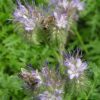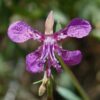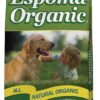Key Takeaways
- Identifying pet-safe plants is essential for creating a garden that is both beautiful and non-toxic to your furry friends.
- Herbs like basil and thyme are great for dogs and can be grown in containers easily.
- When selecting flowers, opt for varieties like African violets and orchids which pose no threat to pets.
- Always choose pet-friendly soil and fertilizers for your container plants to prevent accidental poisoning.
- Stay vigilant by regularly checking your garden for plants that could harm your pets, and know what to do if they ingest something toxic.
Here is a table comparing different flowering, pet-safe, drought-tolerant, and perennial plants:
| Plant Name | Description | Care Tips | Photo | Drought Tolerant | Perennial |
|---|---|---|---|---|---|
| African Violet[4] | Vibrant purple flower that blooms year-round with proper care | Bright indirect light, moderate watering | 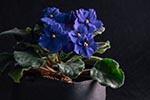 | Yes | No |
| Alyssum[2] | Low-growing plant with small, fragrant flowers | Full sun, moderate watering | 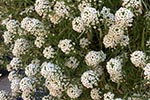 | Yes | Yes |
| Asters[2] | Tall, upright plant with daisy-like flowers | Full sun, moderate watering | 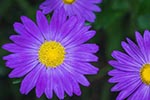 | Yes | Yes |
| Catchfly | Tall, resilient with clustered flowers usually pink, red or white. | Full sun, afternoon shade, well-drained soil. | 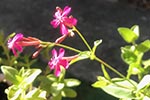 | Yes | Yes |
| Celosia[1] | Also known as “cockscombs” with crested flower heads. | Full sun, well-drained soil | 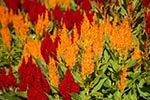 | Yes | Yes |
| Chinese Houses[1] | Pagoda tower of purple or blue flower clusters with white upper lip | Moist soil in part shade, part sun | 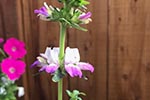 | No | No |
| Cornflower[1] | Brightly colored flowers sometimes called “Bachelor Buttons” | Full to part sun, well-drained soil | 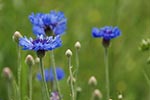 | Yes | Yes |
| Coreopsis[1] | Bright yellow and orange, daisy-like flowers on tall stems | Full sun, well-drained soil | 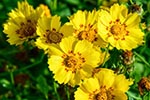 | Yes | Yes |
| Cosmos | Tall daisy-like in various colors, including pink, orange, red, yellow and white. | Full sun, moderate watering | 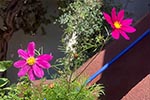 | Yes | Yes |
| Delosperma[1] | Succulent with vibrant daisy-like flowers | Full sun, well-drained soil | 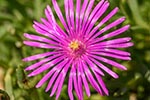 | Yes | Yes |
| Lavender[2] | Fragrant, drought-tolerant plant with purple flowers | Full sun, low watering | 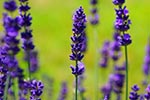 | Yes | Yes |
| Orchid[2] | Exotic, long-lasting flowers with a wide variety of colors and shapes | Bright indirect light, moderate watering |  | Yes | No |
| Pansy[2] | Low-growing plant with large, colorful flowers | Full sun, moderate watering | 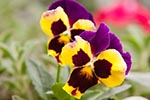 | Yes | Yes |
| Petunia[2] | Trailing or mounding plant with trumpet-shaped flowers | Full sun, moderate watering | 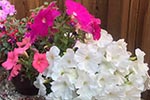 | Yes | Yes |
| Rose[2] | Thorny shrub with fragrant, showy flowers | Full sun, moderate watering | 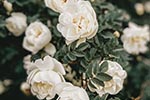 | Yes | Yes |
| Salvia/Sage[4] | Spikes of blue, purple, or white flowers | Full sun to full shade, well-drained soil | 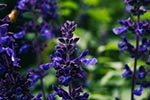 | Yes | Yes |
| Snapdragons | Hardy annual with multi-colored florets resemble a dragon’s snout | Full sun to partial shade, moderate watering | 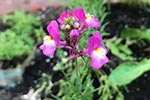 | Yes | Yes |
| Spotted Dead Nettle[2] | Silver or variegated foliage with pink or white flowers | Partial shade, well-drained soil | 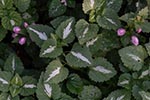 | Yes | No |
| Sunflower[2] | Tall, upright plant with large, bright yellow flowers | Full sun, moderate watering | 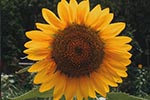 | Yes | Yes |
| Zinnia[2] | Tall, upright plant with daisy-like flowers in various colors | Full sun, moderate watering | 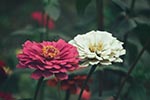 | Yes | Yes |
bold= click for specific grow and care tips
My Advice to All Pet Safe Gardeners
You can do all the research in the world and take every precaution, but the doody can still hit the fan. Lovie and I have endured over $40k in veterinary bills since the pandemic, including $10k for hospitalization for lepto even though he was vaccinated. I understand that it is a personal decision, and yet, I am going to strongly urge you to GET PET INSURANCE!
Click here for a comparison.
Creating a Pet-Safe Garden: The Basics
For those of us who cherish our pets as family, ensuring their safety is a top priority. When it comes to our gardens, this means choosing plants that are safe for our dogs and cats to be around. As we create our green spaces, especially in containers where plants can be within easy reach of our pets, we must be selective and informed about the plants we include.
Why Choosing Non-Toxic Plants Matters
Many common garden plants can be harmful to pets if ingested. Even if your pet isn’t known for nibbling on greenery, it’s best to err on the side of caution. The consequences of consuming toxic plants can range from mild gastrointestinal upset to severe health issues, and in some cases, can even be fatal.
- Prevents potential health emergencies.
- Reduces the risk of costly vet bills due to poisoning.
- Ensures peace of mind knowing your garden is a safe place for pets.
Therefore, being proactive and choosing pet-safe plants from the start is crucial for their well-being.
Understanding Plant Toxicity Levels
It’s important to understand that plant toxicity can vary. Some plants may cause a mild reaction, such as drooling or vomiting, while others can have more serious consequences like kidney failure or heart problems. Knowing the toxicity level of the plants you’re interested in is key to a safe pet environment.
Here’s what to keep in mind:
- Consult reliable resources like the ASPCA’s list of toxic and non-toxic plants.
- When in doubt, talk to your vet about the safety of specific plants.
- Remember that ‘non-toxic’ does not mean ‘will not cause any reaction’—some pets may have sensitivities or allergies to certain plants.
With this foundational knowledge, you can begin selecting plants that will keep your pets safe and your garden flourishing.
The Safe List: Plants for Your Pooch
Herbs and Greens Canines Can Enjoy
Herbs are a wonderful addition to any garden, and many are safe for dogs. They can be grown in containers, making them perfect for patios or balconies. Here are some dog-friendly herbs:
- Basil: A fragrant herb that’s safe for dogs and can enhance many dishes.
- Thyme: Another safe option that’s easy to grow and has a variety of culinary uses.
- Parsley: While generally safe, it’s best in moderation due to its high vitamin C content.
These herbs not only add flavor to your cooking but also bring a touch of nature to your home without posing a risk to your dog.
Flowering Plants That Add Style Without Risk
Flowers bring color and life to any garden, and luckily, there are several options that are safe for dogs. Consider adding these to your container garden:
- African Violets: Charming and safe, these flowers are a delightful choice.
- Orchids: Elegant and non-toxic, orchids are a sophisticated touch to any space.
- Snapdragons: With their unique blossoms, snapdragons are both safe and visually interesting.
By choosing these pet-friendly blooms, you can create a vibrant garden space that’s safe for your canine companion.
Shrubs and Bushes: A Safe Bet for Dogs
Shrubs and bushes can be a fantastic addition to your container garden, offering structure and greenery. When selecting these larger plants, it’s crucial to ensure they are non-toxic to dogs. Here are some dog-safe options:
- Roses: While the thorns can be a concern, the plant itself is safe for dogs.
- Forsythia: Known for their bright yellow flowers, forsythia bushes are non-toxic to dogs.
- Hawthorn: Another dog-safe choice, hawthorn can be pruned to fit into containers.
Opting for these shrubs and bushes means you can design a lush, layered garden that’s also pet-friendly.
Example: My neighbor once had a scare when their curious puppy chewed on a sago palm. Thankfully, they knew the signs of plant poisoning and rushed their pup to the vet in time. It was a stark reminder of the importance of pet-safe gardening.
Stories like these emphasize why we must be vigilant about the plants we bring into our homes and gardens. Let’s continue to explore how we can create a safe haven for our pets.
Safe and Stimulating: Cat-Friendly Herbs
Cats love to nibble on plants, and catnip isn’t the only herb on the menu that’s safe for them. Planting a small container herb garden for your feline friend can provide them with entertainment and health benefits. Consider these cat-friendly herbs:
- Catnip: Naturally, this is a favorite for many cats and can provide hours of fun.
- Valerian: Similar to catnip, valerian can stimulate cats and is often used in toys and treats.
- Lemongrass: While not for frequent nibbling, lemongrass can be a safe treat in small amounts.
These herbs can be grown indoors or outdoors in containers, making them easily accessible to your cat while keeping them contained and controlled.
Non-Toxic Flowers for Feline Households
Cats can be just as curious as dogs, and with their agile nature, they can reach places dogs can’t. That’s why it’s equally important to choose non-toxic flowers for homes with cats. Here are some safe options:
- Spider Plants: Not only are they safe, but they also help purify the air in your home.
- Marigolds: These bright flowers are non-toxic to cats and can deter pests in the garden.
- Zinnias: A safe choice for cats, zinnias add a splash of color to any container garden.
By selecting these flowers, you’ll ensure your feline friend can explore your garden without any health risks.
Suitable Shrubs for Cats: Looks and Safety
When it comes to shrubs and bushes for container gardens, cat owners should be just as cautious. Many common shrubs can be toxic to cats, but there are still plenty of safe and attractive options:
- Bamboo: Fast-growing and safe for cats, bamboo can provide a lush, tropical feel.
- Hibiscus: These large, vibrant flowers are safe for cats and make a bold statement.
- Blue Echeveria: A type of succulent, it’s safe for cats and adds a modern touch.
Integrating these plants into your container garden will create a pet-safe oasis that both you and your cat can enjoy.
Remember, even with pet-safe plants, it’s always best to discourage your pets from chewing on any plants. Some cats may have sensitive stomachs, and even non-toxic plants can cause vomiting or diarrhea if ingested in large amounts.
Container Gardening with Pet Safety in Mind
Container gardening offers a versatile way to bring nature into your home while keeping control over what your pets can access. However, it’s not just the plants themselves that need to be pet-safe – the soil and fertilizers you use are just as important.
Selecting the Right Soil and Fertilizers
When filling your containers, opt for organic potting soil that doesn’t contain any chemical fertilizers or pesticides. These can be harmful if your pet decides to dig or nibble on the dirt. For fertilizers, choose pet-friendly options that are labeled as safe for animals. These are often made from natural materials that won’t harm your pets if they come into contact with them.
Here are some tips for choosing safe soil and fertilizers:
- Look for organic products with a clear label indicating they are pet-safe.
- Avoid using cocoa mulch, as it contains theobromine, which is toxic to dogs and cats.
- Compost can be a great natural fertilizer, but ensure it doesn’t contain any food waste that could be harmful to pets.
Strategic Placement of Plants to Prevent Pet Contact
Even with pet-safe plants, it’s wise to place them strategically to minimize the risk of your pet getting into them. Elevated plant stands, hanging baskets, or shelves can keep plants out of reach of curious paws and noses. Be mindful of trailing vines or leaves that might tempt a pet to jump or climb to reach them.
Consider these placement tips:
- Use wall-mounted planters to keep plants at a safe height.
- Place heavier pots on the ground to prevent tipping and spillage.
- Ensure all plants are stable and secure to prevent accidents.
Safe Decorative Elements to Enhance Your Container Garden
Decorating your container garden can add personality and style, but safety should come first. Avoid small, chewable decorations that could be choking hazards. Instead, opt for larger, sturdy items that can’t be easily swallowed or knocked over. Decorative rocks, for example, can add a natural touch without posing a risk.
Here are some safe decorative ideas:
- Large river stones or glass pebbles can add color and texture.
- Use driftwood or larger shells to create a beach theme without small, swallowable pieces.
- Incorporate pet-safe solar lights to illuminate your garden at night.
With these tips, your container garden will not only be a beautiful addition to your home but also a safe environment for your pets to enjoy.
Petscaping: Pet-Safe Landscaping
Creating a pet-safe landscape, or ‘petscaping,’ is about more than just picking the right plants. It’s about designing an environment that is enjoyable and secure for your pets to spend time in. This means considering everything from the types of plants to the layout of your garden space.
When planning your petscape, remember to:
- Choose plants that are non-toxic to both dogs and cats.
- Design pathways and open areas for your pets to roam freely and safely.
- Include shaded areas where your pets can relax out of the sun.
By considering these elements, you’ll create a garden that’s not just a joy to look at but also a pleasure for your pets to explore.
Outdoor Plant Choices for a Pet Zen Space
Creating a tranquil outdoor space for you and your pets can be achieved by selecting the right plants. Lavender, for instance, is known for its calming scent and is safe for dogs. Similarly, cat grass is a great choice for feline friends and can be grown in small containers for them to graze on.
Here are a few plants that can contribute to a pet zen garden:
- Lavender: Soothing for you and safe for dogs.
- Cat Grass: A healthy treat that can aid in digestion for cats.
- Camellia: Beautiful flowers that are safe for pets and can add a touch of elegance.
With these plants, your outdoor space can become a serene haven for both you and your pets to relax and unwind.
Maintaining Container Plants without Endangering Pets
Maintaining your container plants is essential to ensure they thrive, but it’s also important to do so without putting your pets at risk. Use non-toxic pest control methods, such as soapy water sprays, to deal with insects. Regularly trim and remove dead leaves to prevent mold and mildew, which could harm your pets if ingested.
Keep these maintenance tips in mind:
- Water plants in the morning to reduce dampness at night, which can lead to fungal growth.
- Check for pests regularly and use pet-safe methods to control them.
- Keep pruning tools clean and out of reach to prevent injuries.
By following these guidelines, you’ll keep your garden beautiful and your pets safe.
Maintaining Your Pet-Safe Garden
Having a pet-safe garden is an ongoing commitment. Regularly inspect your garden for any new plants that may have sprouted and could be dangerous. Keep an eye on your pets when they’re in the garden, and be prepared to act quickly if they show signs of having ingested something harmful.
Most importantly, stay informed. Plant safety for pets can change as new research emerges, so keep up to date with the latest information from trusted sources.
Here’s how to maintain vigilance:
- Periodically review the ASPCA’s list of toxic and non-toxic plants.
- Watch for any changes in your pet’s behavior that could indicate they’ve ingested something harmful.
- Have your vet’s number and the number for the pet poison hotline readily available in case of an emergency.
For example, if you notice your dog drooling excessively or your cat vomiting after being in the garden, it could be a sign they’ve eaten something they shouldn’t have. Quick action could save their life.
By being proactive and attentive, you can enjoy the rewards of a beautiful garden without compromising the safety of your beloved pets.
Regular Checks for Hidden Dangers in the Garden
Keeping your garden safe for pets means regular patrols are a must. Check for any plants that have crept in or been planted inadvertently that may pose a threat. Look out for mushrooms, which can sprout quickly and be highly toxic, and keep an eye out for any garden visitors like toads, which can also be dangerous if your pet decides to investigate with their mouth.
Emergency Protocols: What to Do If Ingestion Occurs
If you suspect your pet has ingested a toxic plant, act fast. Remove any plant material from their mouth and keep a sample for identification. Contact your veterinarian immediately or call the ASPCA Animal Poison Control Center (APCC) at (888) 426-4435. Time is of the essence, so don’t wait for symptoms to appear before seeking help.
FAQ: Expert Answers to Your Pet Plant Safety Questions
What to do if your pet eats a potentially toxic plant?
First, remain calm but act swiftly. If you see your pet consume part of a potentially toxic plant, try to gently remove any remaining pieces from their mouth. Do not induce vomiting unless instructed by a professional. Then, immediately call your vet or a pet poison hotline and follow their instructions precisely.
How to train pets to avoid garden areas?
Training your pets to stay out of garden areas can be challenging. However, with consistent training and the right strategies, you can teach your furry friends to respect your garden spaces. It’s important to create a clear boundary for your pets and use positive reinforcement to reward them for staying out of the garden. Consider using safe, pet-friendly deterrents to discourage them from entering the area.
Training your pets to stay out of certain areas can be challenging but is possible with consistency and patience. Use positive reinforcement to teach them where they can and cannot go. Create barriers or use pet deterrents in the garden to discourage them from entering. Always supervise your pets when they are outside.
Can any common plants cause allergies in pets?
Yes, just like humans, pets can have
Keeping your garden safe for pets means regular patrols are a must. Check for any plants that have crept in or been planted inadvertently that may pose a threat. Look out for mushrooms, which can sprout quickly and be highly toxic, and keep an eye out for any garden visitors like toads, which can also be dangerous if your pet decides to investigate with their mouth.
Emergency Protocols: What to Do If Ingestion Occurs
If you suspect your pet has ingested a toxic plant, act fast. Remove any plant material from their mouth and keep a sample for identification. Contact your veterinarian immediately or call the ASPCA Animal Poison Control Center (APCC) at (888) 426-4435. Time is of the essence, so don’t wait for symptoms to appear before seeking help.
In the event that your pet has consumed something harmful, your quick response can make all the difference. Keep a pet first aid kit on hand and ensure it includes the number for your local emergency vet clinic and the APCC. This way, you’re always prepared for any situation that may arise.
While it’s essential to react quickly, prevention is always better than cure. Therefore, make sure that your garden is free from plants known to be toxic to pets, and keep hazardous substances such as pesticides and fertilizers out of reach.
- Remove plant material from your pet’s mouth.
- Keep a sample of the plant for identification.
- Contact your veterinarian or the APCC immediately.
- Do not wait for symptoms to seek professional help.
FAQ: Expert Answers to Your Pet Plant Safety Questions
What to do if your pet eats a potentially toxic plant?
First, remain calm but act swiftly. If you see your pet consume part of a potentially toxic plant, try to gently remove any remaining pieces from their mouth. Do not induce vomiting unless instructed by a professional. Then, immediately call your vet or a pet poison hotline and follow their instructions precisely.
How to train pets to avoid garden areas?
Training your pets to stay out of certain areas can be challenging but is possible with consistency and patience. Use positive reinforcement to teach them where they can and cannot go. Create barriers or use pet deterrents in the garden to discourage them from entering. Always supervise your pets when they are outside.
Can any common plants cause allergies in pets?
Yes, just like humans, pets can have allergies to plants. Signs of an allergic reaction may include itching, sneezing, or skin irritation. If you notice these symptoms and suspect a plant allergy, consult your veterinarian for advice and treatment options. Common allergenic plants for pets include certain grasses and flowers, so be sure to research the plants in your garden if your pet has known sensitivities.
How often should you update your pet-safe plants list?
It’s wise to review and update your list of pet-safe plants annually or whenever you plan to add new plants to your garden. This ensures you’re up-to-date with the latest information and can make informed decisions about what to grow. Additionally, keep an eye on news from organizations like the ASPCA for any updates on plant safety for pets.
What resources can verify the safety of plants for pets?
Several resources can help verify the safety of plants for pets. The ASPCA provides a comprehensive list of toxic and non-toxic plants for both dogs and cats. Additionally, your local veterinarian can offer advice based on their professional experience and knowledge of local plant life. Gardening books and websites dedicated to pet safety are also valuable resources.
When choosing outdoor container plants that are safe for your furry friends, it’s important to do your research. Many common plants can be toxic to dogs and cats if ingested. To create a pet-friendly garden, look for plants such as catnip, petunias, or rosemary, which are non-toxic to both dogs and cats. Always ensure that the plants you choose are suitable for your climate and the amount of sunlight your garden receives.
These plants are safe for both cats and dogs, making them ideal for pet-friendly homes. They are also drought-tolerant, making them suitable for low-maintenance gardens. The table indicates whether each plant prefers full sun or can tolerate partial shade, providing options for different garden exposures. Remember to keep plants out of reach of pets to prevent any potential issues, such as ingestion[1].
Citations:
[1] http://www.perennialresource.com/photo_essay.php?ID=311
[2] https://savvygardening.com/drought-tolerant-shade-plants/
[3] https://www.bhg.com/gardening/flowers/perennials/tough-perennials-that-grow-in-dry-shade/
[4] https://www.epicgardening.com/drought-tolerant-shade-perennials/
[5] https://www.birdsandblooms.com/gardening/drought-tolerant-gardening/top-10-drought-tolerant-plants/
[6] https://www.gardendesign.com/annuals/vs-perennials.html
[7] https://www.marthastewart.com/8380132/perennial-vs-annual-definition-plant6
[8] https://www.bhg.com/gardening/flowers/perennials/difference-between-annual-and-perennial-plants/
[9] https://www.gardenheights.com/single-post/2018/03/30/whats-the-difference-between-perennial-and-annual-plants
[10] https://www.realsimple.com/home-organizing/gardening/outdoor/perennials-vs-annuals

